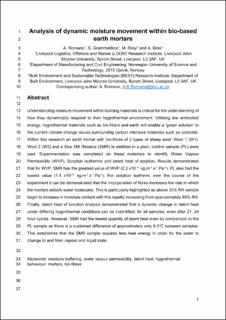| dc.contributor.author | Romano | |
| dc.contributor.author | Grammatikos, S. | |
| dc.contributor.author | Riley, M. | |
| dc.contributor.author | Bras, A. | |
| dc.date.accessioned | 2021-11-04T13:36:28Z | |
| dc.date.available | 2021-11-04T13:36:28Z | |
| dc.date.created | 2021-11-01T11:10:25Z | |
| dc.date.issued | 2021 | |
| dc.identifier.issn | 0950-0618 | |
| dc.identifier.uri | https://hdl.handle.net/11250/2827950 | |
| dc.description.abstract | Understanding moisture movement within building materials is critical for the understanding of how they dynamically respond to their hygrothermal environment. Utilising low embodied energy, hygrothermal materials such as bio-fibers and earth will enable a ‘green solution’ to the current climate change issues surrounding carbon intensive materials such as concrete. Within this research an earth mortar with bio-fibres of 2 types of sheep wool: Wool 1 (W1), Wool 2 (W2) and a Saw Mill Residue (SMR) in addition to a plain, control sample (PL) were cast. Experimentation was completed on these materials to identify Water Vapour Permeability (WVP), Sorption Isotherms and latent heat of sorption. Results demonstrated that for WVP, SMR has the greatest value of WVP (2.2 x10−11 kg.m−1.s−1.Pa−1). PL also had the lowest value (1.4 x10−11 kg.m−1.s−1.Pa−1). For sorption isotherm, over the course of the experiment it can be demonstrated that the incorporation of fibres increases the rate in which the mortars adsorb water molecules. This is particularly highlighted as above 30% RH sample begin to increase in moisture content with this rapidly increasing from approximately 65% RH. Finally, latent heat of sorption analysis demonstrated that a dynamic change in latent heat under differing hygorthermal conditions can be indentified; for all samples, even after 21, 24 h cycles. However, SMR had the lowest quantity of latent heat even by comparison to the PL sample as there is a sustained difference of approximately only 0.5 °C between samples. This establishes that the SMR sample requires less heat energy in order for the water to change to and from vapour and liquid state. | en_US |
| dc.language.iso | eng | en_US |
| dc.publisher | Elsevier | en_US |
| dc.rights | Attribution-NonCommercial-NoDerivatives 4.0 Internasjonal | * |
| dc.rights.uri | http://creativecommons.org/licenses/by-nc-nd/4.0/deed.no | * |
| dc.title | Analysis of dynamic moisture movement within bio-based earth mortars | en_US |
| dc.type | Peer reviewed | en_US |
| dc.type | Journal article | en_US |
| dc.description.version | acceptedVersion | en_US |
| dc.rights.holder | This is the authors' accepted manuscript to an article published by Elsevier. Locked until 14.9.2023 due to copyright restrictions. The AAM is made available under the CC-BY-NC-ND 4.0 license http://creativecommons.org/licenses/by-nc-nd/4.0/ | en_US |
| dc.source.journal | Construction and Building Materials | en_US |
| dc.identifier.doi | 10.1016/j.conbuildmat.2021.124862 | |
| dc.identifier.cristin | 1950114 | |
| cristin.ispublished | true | |
| cristin.fulltext | postprint | |
| cristin.qualitycode | 2 | |

